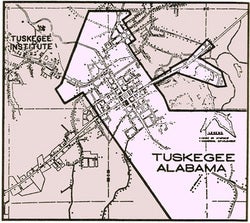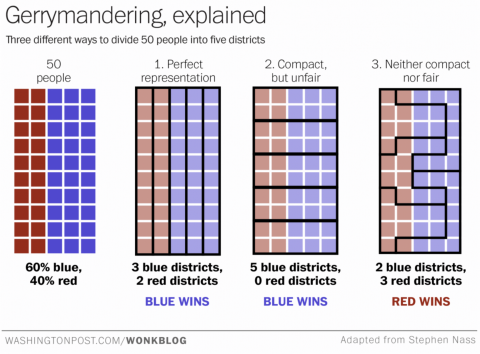In the great Peter Benchley movie, Jaws, there is a wonderful scene where several of the denizens of Amity pose by the shark they captured. The mayor proclaimed victory, the town slept well and the beaches were open.
Ding-dong, the shark was dead.
Well, not actually. This shark was dead. But the shark they were hunting was alive and well—as Hooper and Brody discovered when they examined the shark that had been caught.
The current feeding frenzy about gerrymandering is similarly misguided. This term, the Supreme Court will hear the case of Whitford v. Gill. Once and for all, the media proclaim, the Supreme Court has the chance to do SOMETHING and solve this gerrymandering problem. The solution comes in the form of the “Efficiency Gap,” a measure generated by my colleagues Nick Stephanopoulos and Eric McGhee. In short, the Efficiency Gap compares the number of “wasted votes” cast for the Democrats or Republicans in a state’s legislative or congressional elections and compares that difference to the difference in the percentage of seats the parties hold in the legislature or congressional delegation. The bigger the ratio, the worse the gerrymander.
The simplicity of the Efficiency Gap is so tremendously appealing that it has hypnotized many critics and analysts in the media. In its Sunday magazine, The New York Times proclaimed that math was finally being brought to bear on the hunt for the elusive gerrymander. The Washington Post declared this August that North Carolina boasted one of the nation’s worst gerrymanders.
The Post (specifically Christopher Ingraham) was certainly justified in its outrage. Once again, a state legislature had drawn election districts to suit the desires of the legislators, not the needs of the voters. Put differently, elected officials had chosen their voters instead of the other way around. The latter is democracy; the former is a ridiculous, obvious conflict of interest.
Clearly, something is wrong when the same elected bodies that no longer allow banks or savings and loans or virtually anyone else to regulate themselves chooses to regulate itself and, specifically, to condition the process by which its members are returned to office. There no other way to describe this: it is a conflict of interest.
Some states have chosen to remove the veneer of legislative self-dealing by employing redistricting commissions to draw their election districts. Yet, litigation ensues because the redistricting process is constrained by constitutional and statutory principles that make it difficult to draw districts. The Supreme Court ruled long ago that election districts must have equal populations. When Congress passed the Voting Rights Act, it forced states to take race into account and, for all intents and purposes, draw districts that ensure that minority voters have the opportunity to elect candidates of their choice.
The Voting Rights Act, like the Civil Rights Acts of the 1960s, are testament to the nation’s willingness and capacity to acknowledge our discriminatory past and make amends. Racist governments had denied black, Hispanic and other voters access to the polls and, when that was stopped by the expansion of the franchise, they resorted to literacy tests and gerrymandering to keep them away from the polls or to divide them up so they could not exercise political power.
Perhaps the most notorious example of this practice occurred in Tuskegee, Alabama. The city center was populated by whites. The periphery had a majority black population that had grown to the point where black voters were a majority of the voting population. So, to prevent them from governing themselves and the city, the state legislature decided to convert the city boundary from its square form to the following figure that the Supreme Court described as “uncouth” in Gomillion v. Lightfoot (364 U.S. 339 (1960)

(source: http://maconhistory.weebly.com/tuskegee-boycott.html)
The problem is that, to remedy this history of racist practices requires that states engage in exactly the same process of drawing legislative districts that will produce particular results. In this case, districts must be drawn, where possible, to give minority voters the opportunity to elect representatives of their choice. The result is that states such as North Carolina, must find ways to snake district lines here and there in order to pick up enough pockets of minority voters to ensure that they comprise an electoral majority (or close enough to it to ensure that the minority preferred candidate can be elected). The result is districts that look like the famous 12th district in North Carolina that led to the Shaw v. Reno decision in 1992.

(source: http://www.senate.mn/departments/scr/GRAPHICS/nccd12.gif)
While they are busy drawing districts that have equal populations, conform to the Voting Rights Act and any state constraints (such as keeping districts geographically compact or keeping municipal boundaries intact), state legislators also look to keep their own constituencies intact. As a result, we are peppered with news articles and images of contorted districts whenever district lines are redrawn.
But Where is the Gerrymander?
It is easy to detect a racial gerrymander. One needs only to locate and count the black or Hispanic residents of a state and determine whether districts have been drawn in a manner that dilutes their voting power. Partisan gerrymanders—the focus of the Whitford v. Gill case currently before the Supreme Court—are another matter entirely.
Partisan gerrymandering analysis frequently begins with simplistic (not simple) and misleading images such as the graphic image that the Washington Post uses to depict a gerrymander.

(source: https://img.washingtonpost.com/wp-apps/imrs.php?src=https://img.washingtonpost.com/blogs/wonkblog/files/2015/03/gerry.png&w=480)
In this image, Democrats and Republicans are presented as color coded characters (Red for Republican, Blue for Democratic) in the same way that black and white voters might be presented as black and white squares. In this image, it is shown that a polity that is 60% blue and 40% red can be carved up in ways that over-represent blue voters or red voters, depending on how the lines are drawn.
The problem with this is that it is misleading. Race is an immutable characteristic. No matter where district lines are drawn, no matter what district you are in, your race remains the same. But, you might change the way you vote once you see who the candidates are in your new district. As a result, in the real world, as you redraw those lines, some of those red squares will become blue and vice versa.
We know this. Political scientists and pollsters have demonstrated for years that Americans are not partisan robots who walk into the voting booth and vote only for one party or the other. We pick our candidates on the basis of issues. Certainly, the tendency to vote only for one party varies over time (and, nowadays, partisan lines are much stronger than they once were). But, that only reinforces the point: partisanship is not fixed. We split our votes for the president and congress. Sometimes we don’t vote because our incumbent is too strong or unchallenged. We change our voting in response to changes in Election Day choices. As the great political scientist V. O. Key said long ago, “voters are not fools.”
In fact, a seldom reported truth about the 19th century map of Massachusetts legislative districts that gave its name to the gerrymander is that…IT DIDN’T WORK! No kidding.
As I document in my book Does Redistricting Make a Difference, the district was drawn to knock a Federalist candidate out of office. It worked at first. But, in the next election, the Federalists took back the district. The voters changed their minds… So, what was the harm?
As a result, the notion that votes are wasted is nonsensical. It’s ok to vote for the losing candidate. It’s ok sometimes for one candidate to win in a landslide because she is very popular. In other cases, it’s ok for another candidate to lose by a slim margin in a nail-biter of an election because both candidates are popular.
So, using the Efficiency Gap to measure wasted votes and determine whether a state has been gerrymandered overlooks the realities of voting in the United States. The Efficiency Gap is remarkably consistent. It does compare so-called wasted votes to the number of seats each party has and, on that basis, offers a measure of difference. But, how meaningful is the difference and what can we do about it?
The answer is: very little.
So long as the USA uses single-member districts to elect its legislators (this is how we choose the Congress and virtually all state legislative seats) there will always be so-called wasted votes. In a winner-take-all system such as ours, only one candidate can win. As a result, some voters will vote for the losing candidates. So long as we keep this system, it is silly to call these votes “wasted.” They are part and parcel of the method of voting.
No matter how we draw or redraw district lines, there will be an imbalance in electoral results because some incumbents are unbeatable or so popular that they scare off opponents and cause voters to cross party lines to vote for them. So long as minority voters tend to be packed together in particular urban areas or so long as it is possible to snake district lines across a state to piece together enough minority voters to control a legislative election, there will be lots of “wasted” votes as minority incumbents coast to easy victories.
No matter how bad one set of districts is, the only solution is to draw another set…of single member districts. So, no matter what we may infer from the Efficiency Gap, the fact is that it is more of a measure of how our electoral system works than a measure of partisan injustice.
There really is a solution to this problem of gerrymandering. First, it’s a solid idea to turn redistricting over to nonpartisan commissions. This will at least remove the conflict of interest that inheres in our system.
Second, we could change the way we chose our legislators. In numerous cities across the country, voters vote for more than one candidate. Maine no longer allocates all of its Electoral College votes with a winner-take-all system. Across the world—and across American history—many different electoral systems have been used that overcome the threat of gerrymandering and the problem of wasted votes.
Unfortunately, the only way for this to happen is for our legislators—who benefit from that winner-take-all system—to change the electoral system. If gerrymandering district lines is in their self-interest, there is no question that changing the electoral system would seem to be a threat. But, it isn’t. Candidates would have to campaign differently. But, we’d still have elections. Voters would never be faced with an unbeatable incumbent or an uncontested election. Democracy and elections would always involve choices.
As you follow the coverage of the Whitford case this year, think critically about what’s really at stake—and what is being debated in the Supreme Court and the media. It’s about much more than an Efficiency Gap or any other measure of wasted votes. What’s really at stake is the quality of our elections.
Alas, no matter what happens in the Supreme Court, one side or the other will declare victory and—like the fishermen in Jaws--pose by the shark or, in this case, the gerrymander that was the prize. Unfortunately, the real threat will still be out there. But, unlike the great white shark that posed an obvious, immediate threat, the injustices that underpin our electoral system will continue to nibble away at our democracy like termites. Sadly, we seldom realized the damage caused by termites until it’s too late…